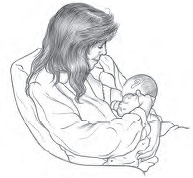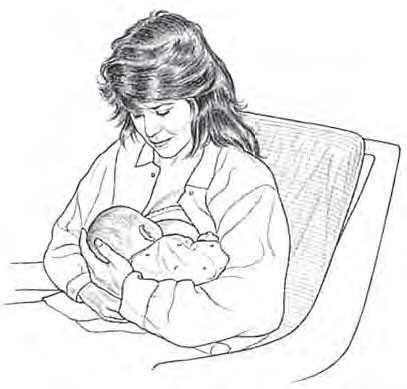Most new mothers first try breastfeeding sitting up in a hospital bed, with the baby supported by a pillow in their lap and cradled in their arms. If you choose this position, elevate the head of the bed as much as possible and place pillows behind you until your back is comfortable. Place your baby on a pillow on your lap (this is an especially good idea if you've given birth by cesarean section, or C-section) so his head is level with your breast. Put pillows at your sides to rest your arms on so they won't tire in mid-feeding.
Get comfortable
At home, you may find an armchair helpful. If you breastfeed while sitting in a chair, be sure it offers sturdy back and arm support and is not too low or high. A pillow or two tucked behind your back can make nursing in a chair more comfortable, as can a low footstool to support your legs. It is always important to make sure that you are comfortable before beginning the feeding.
Whether you are sitting up in bed or have settled into an armchair, keep your back straight but relaxed as you offer your baby the breast. Your baby may find it more difficult to latch on properly if you are leaning forward or back. This changes the angle at which the baby receives the breast, and your back may soon feel the strain of this as well. If your breasts are large, you might want to place a rolled-up towel or receiving blanket beneath your breast to keep your baby's mouth at a straight-on angle with the nipple, in addition to supporting the breast with your hand.
Once you are comfortably positioned, you can hold your baby in a number of ways. As you practice breastfeeding before leaving the hospital, try several positions (for both your baby and yourself) and ask your nurse or lactation specialist for assistance if needed. Feeding in more than one position can help prevent nipple soreness and clogged milk ducts, since different positions drain different areas of the breast more effectively. Some positions also work better than others in certain circumstances.
All of these positions described are for guidance only. There is not an absolute right or wrong way to hold your baby for breastfeeding. Every mother and baby find the positions that work well for them. If you are a first-time breastfeeding mother, however, you may find the following guidance helpful for getting started.
The cradle hold
 The traditional position is called the cradle hold or
Madonna hold. For this position, support your baby on the arm that's on the same side as the breast you intend to use. Holding your upper arm close to your body, rest your baby's head in the crook of your elbow, support his back with your forearm, and cup his bottom or upper thigh with your hand. His arm may be positioned around your body or tucked slightly under his body to keep it out of the way. Once he's properly supported, rotate your forearm so his entire body turns toward you. His pelvis should be up against your abdomen, his chest against your chest, and his mouth lined up with your nipple. You can now bring your baby's mouth to the nipple (rather than the nipple to his mouth) without making him turn his head to the side. It is important for your baby's head to be aligned with the rest of his body instead of turned off to the side.
The traditional position is called the cradle hold or
Madonna hold. For this position, support your baby on the arm that's on the same side as the breast you intend to use. Holding your upper arm close to your body, rest your baby's head in the crook of your elbow, support his back with your forearm, and cup his bottom or upper thigh with your hand. His arm may be positioned around your body or tucked slightly under his body to keep it out of the way. Once he's properly supported, rotate your forearm so his entire body turns toward you. His pelvis should be up against your abdomen, his chest against your chest, and his mouth lined up with your nipple. You can now bring your baby's mouth to the nipple (rather than the nipple to his mouth) without making him turn his head to the side. It is important for your baby's head to be aligned with the rest of his body instead of turned off to the side.
The cross-cradle hold
A variation on the cradle hold, the cross-cradle or crossover hold involves the same positioning except you support your baby on the arm opposite the breast being used. In this position, your hand supports your baby's neck and upper back, rather than his bottom, and his bottom rests either in the crook of your arm or on the pillow on your lap. Again, rotate your baby's body so it faces you and his mouth is lined up with your nipple. This is a good position for a baby who has difficulty latching on, because you can more easily guide his head into a better position by holding the back of his neck between your thumb and fingers. You may use your hand to support the breast while helping your baby to latch.
The laid-back position
Laid-back breastfeeding positioning takes advantage of the biologic responses that occur when the baby is skin-to-skin with the mother in a prone position. This position is sometimes referred to as the
Australian or
down-under position. The mother lies semi-reclined on her back, with the baby lying stomach-to-stomach on top of her. This position is especially useful for mothers who have an overactive let-down reflex or an overabundant milk supply.
The side-sitting, clutch or football Hold
 Many breastfeeding women find that the side-sitting hold, also known as a
clutch hold or
football hold, is an easier position to maintain. This may be especially true for those who have given birth by cesarean delivery, because it keeps the baby's weight off the abdominal incision. The clutch hold may also be useful for mothers of twins since one baby can nurse on each side; for women with large breasts or flat nipples since the mother can see both her nipple and her baby's mouth and can easily control the baby's head; and also for premature babies. In a clutch hold, your baby is held similarly to how you would hold a handbag clutched under your arm or a football clutched close to your body.
Many breastfeeding women find that the side-sitting hold, also known as a
clutch hold or
football hold, is an easier position to maintain. This may be especially true for those who have given birth by cesarean delivery, because it keeps the baby's weight off the abdominal incision. The clutch hold may also be useful for mothers of twins since one baby can nurse on each side; for women with large breasts or flat nipples since the mother can see both her nipple and her baby's mouth and can easily control the baby's head; and also for premature babies. In a clutch hold, your baby is held similarly to how you would hold a handbag clutched under your arm or a football clutched close to your body.
To feed your baby in this position, place him beside you—on the side of the breast you will use—with his head near your breast. Tuck his body up against your side, under your arm. Your forearm should support his upper back, and your hand and fingers should support his shoulders, neck, and head. His legs will stretch out straight behind you or, if you are in a chair, you can rest his bottom against the back of the chair and angle his legs straight up. Finally, place a pillow under your elbow for support, keep your baby's head level with your breast.
Reclining or lying down
 You may find that feeding your baby in a reclining position, rather than sitting, allows for some welcome relaxation. Nursing while lying down helps particularly if you have had a cesarean delivery or otherwise feel tired or unwell in the days following childbirth. To do this, lie on your side with one or more pillows behind your back and under your head for support. (A pillow placed between your knees may make you more comfortable.) Keep your back and hips in as straight a line as possible. Hold your baby closely on his side so he faces you with his mouth with your arm around him. You may use your hand to support the breast while helping the baby to latch.
You may find that feeding your baby in a reclining position, rather than sitting, allows for some welcome relaxation. Nursing while lying down helps particularly if you have had a cesarean delivery or otherwise feel tired or unwell in the days following childbirth. To do this, lie on your side with one or more pillows behind your back and under your head for support. (A pillow placed between your knees may make you more comfortable.) Keep your back and hips in as straight a line as possible. Hold your baby closely on his side so he faces you with his mouth with your arm around him. You may use your hand to support the breast while helping the baby to latch.
An advantage of this position is you don't have to get up to reposition your baby on your other breast. Simply place a pillow under him to elevate him until he's parallel with your upper breast and lean over farther to bring the upper breast to him. Or, if you prefer, hug him to your chest, roll over to your other side, and reposition him. You can support your baby by placing a pillow or rolled-up blanket behind his back, which gives your lower arm a rest.
Remember
Once you and your baby have become pros at breastfeeding, you'll be able to nurse while talking on the phone, reading a book, supervising your other children, or walking around. If you have any questions about breastfeeding your baby, talk with your pediatrician.
More information